


A NEW CLASS OF DRIVERS
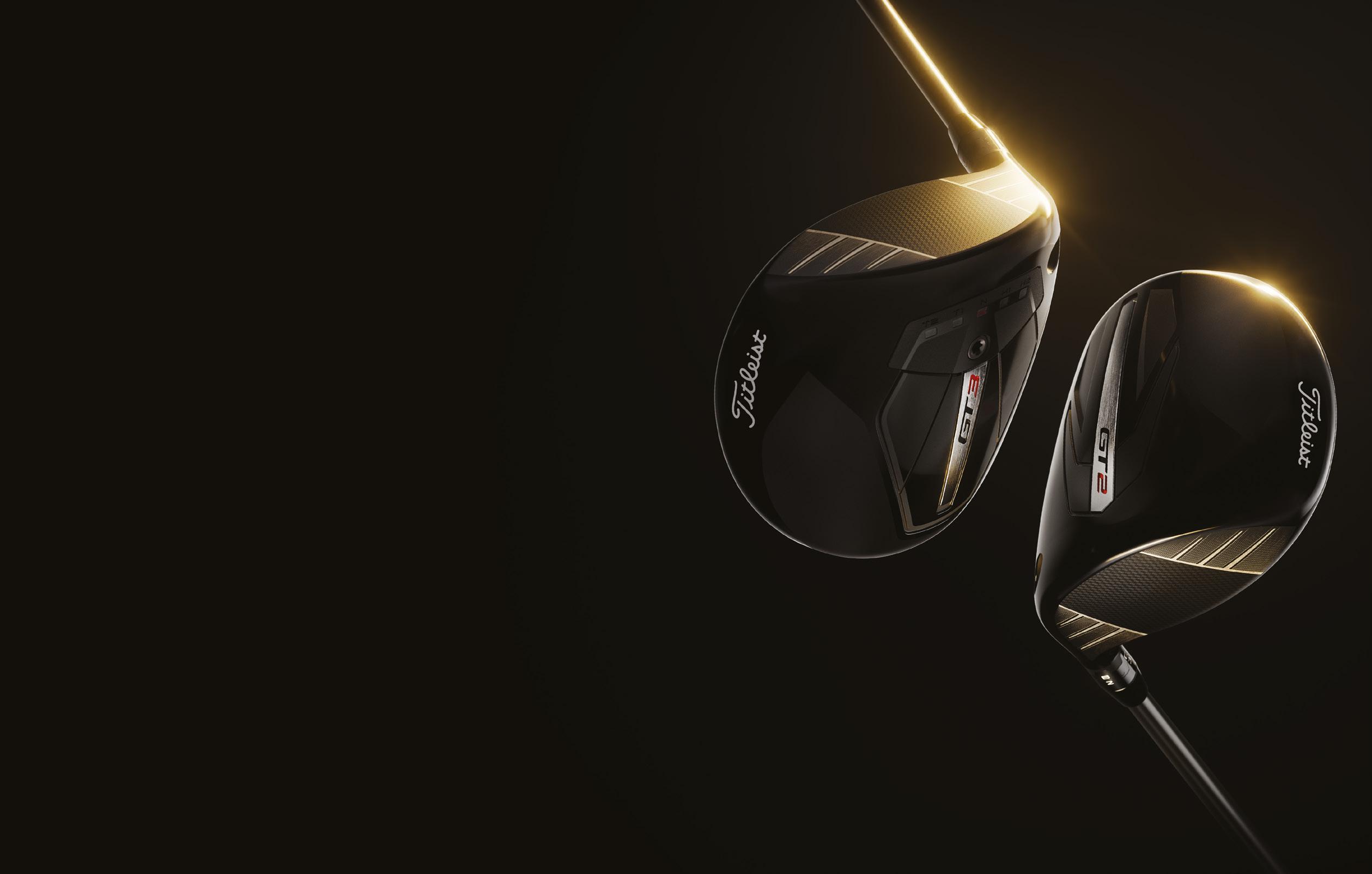











It is with mixed emotions that I write this month’s Voice of the Tour column ahead of my retirement from the European Tour Group following the Open Championship.
Of course, the prospect of spending more time with my family, and indeed playing some more social golf, is something I am looking forward to, but equally the Tour has been such a massive part of my life for the last 47 years.
Prior to joining the Tour’s staff, I played on Tour for 17 seasons, making 384 appearances in total after earning my card in 1979. The 1980s and early 90s were certainly a very different era to be a professional golfer compared to the current landscape, but I had some incredible experiences and I feel very fortunate to have competed alongside some of European golf’s most iconic names, such as Seve Ballesteros, Sir Nick Faldo, Ian Woosnam, Sandy Lyle and Bernhard Langer, who I roomed with in my early days.
They were great times, particularly as the European Tour, as it was known then, began expanding outside of its traditional heartlands of Great Britain, Ireland and continental Europe and into new territories such as Asia, Africa and, of course, in 1989 into the Middle East.
That direction of travel towards golf becoming more international was something that became an even bigger focus for me when I became a golf administrator after calling time on my own playing career.
After initially working on the Seniors Tour – now known as the Legends Tour – I then became the European Tour’s Director of International Policy, followed by Chief Operating Officer in 2007, with the brief of expanding the Tour in some of the territories I previously mentioned and establishing our relationships around the world.
Those relationships continue to benefit the Tour, and indeed golf, today and they have further evolved with the creation of the pathway system recently, enabling emerging talent from our partner Tours in South Africa, Australia, India, China, Japan and Korea to compete globally on the DP World Tour.
I believe golf has huge global potential as a sport and we’ve seen how that potential can be realised if a country or a region embraces it like the Middle East has.
I actually played in the very first Dubai Desert Classic back in 1989 and it has been fascinating to see the evolution and progress that has been made over the last 36 years. We’ve brought some of the world’s leading players to the Middle East during that time and the region now boasts world class facilities to match, meaning many of our players choose to live or to practise there.
When we launched the Race to Dubai in 2008, the concept aimed to give us a compelling season-long narrative and to promote Dubai as a sporting and tourism hub.

The global economic crisis hit shortly after our launch, but we navigated that challenge together and the Race to Dubai now goes from strength to strength, helped also by the success of players such as Rory McIlroy who is aiming for his seventh title in November.
I am very grateful for all the incredible support we have had from DP World, the Emirates Golf Federation and our partners in the Middle East which has been hugely significant, not only in terms of the Race to Dubai, but across all our events in the Middle East.
Establishing relationships has been such an integral and enjoyable part of my job with the Tour and that what I am going to miss most when I retire. I’ve been fortunate to have met so many wonderful people and have so many great experiences with them over the last 47 years.
Hopefully it won’t be the last I see of them though and that I will return to the Middle East as a fan and enjoy our tournaments, along with the culture and the courses, in a different capacity.
For now though, I’d just like to say thank you once again to everyone who has helped make my time with the Tour so very special. It truly has been a privilege.
Keith Waters Chief Operating Officer DP World Tour




BUILT FOR SPEED. Drivers come in all shapes and sizes with claims of more of everything, but unless it’s optimised to your game, your expectations and drives will come up short (and in the rough). In the new G440 drivers, multiple technologies, including a lighter overall system weight and longer shaft, help bring you more ball speed for more distance, more forgiveness and more fun.

GET FIT. GET OPTIMISED.
Mass savings from the Free Hosel help optimise the CG, aligning it with the force line for more distance and fairway-finding forgiveness.

Composite crown contributes to lighter overall system, delivering faster speeds for more distance and a pleasing sound.
Shallow, thin face increases flexing to ensure high-launching results for consistent ball speed on off-centre hits.
Who’s got the nerve, the game, and the grit to conquer links golf’s ultimate test? We break down the players to watch, the weather to fear, and the magic that makes the Open Championship unforgettable.

12 THE OFFICIAL PETE COWEN COLUMN Portrush is back to ruin scorecards. McIlroy dreams big, Lowry relishes the chaos, and Westwood fancies a fairytale. No hiding when the wind howls.
16 THE COURSE: PORTRUSH UNCOVERED
Think you know Royal Portrush? Think again. We’ve dug out the hidden stories behind Northern Ireland’s most famous links—from the secret WWII bunkers to the holes that were reimagined for The Open.
Local and international stories that grabbed the headlines.
20 THE UNKNOWN ASSASSIN
The unheralded Californian, J.J. Spaun, tore up the script at Oakmont with a jaw-dropping back-nine charge to claim the 125th U.S. Open – leaving Rory, Scottie and Bryson in his wake.
26 FROM RANGE TO VIRAL FAME
How a Manchester pro with a camera turned swing tips into a global golf empire, played with the game’s biggest names, and still can’t resist a good launch monitor session.
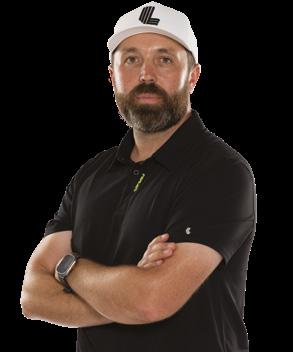


30 LEARN FROM LOWRY
Why Shane’s unorthodox swing could be the secret to your best ball striking yet – setup first, then let it flow.
64 WIN 6 DOZEN TITLEIST PRO V1 BALLS!
Think you’re a DP World Tour mastermind?
Prove it with our ultimate Titleist quiz and bag enough Pro V1s to last all season.




46
VILAMOURA’S GOLF PLAYGROUND



Championship courses, ocean views, and Algarve sunshine—where every round feels like a holiday and every fairway has its own story. 50
42 GOLFING ROYALTY IN SURREY
Four legendary courses— Wentworth, Sunningdale, Royal Mid-Surrey and Worplesdon—set the stage for an unforgettable golf escape just outside London.
Presented
by
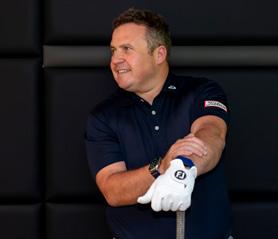

L.A.B. RIVAL?
Discover how the Ai-One Square 2 Square Max putters combine zero-torque stability with AI-powered feel for the most forgiving roll Odyssey has ever produced.

PING i240 TESTED
Precision meets forgiveness in Ping’s latest players’ cavity-back. Higher launch, softer feel, and clever weighting—just be ready for the bold new look.

Stuart Taylor reveals how he went from Lancashire prodigy to Dubai’s leading club-fitter—overcoming hip surgeries, smashing course records and transforming golfers’ games along the way.

From tearing in as a young fast bowler to teeing it up alongside Masters champions, Shyam Bhatia has lived a life steeped in sport.


50
Matt Perry brings Masterslevel inspiration home to elevate the Majlis ahead of golf’s biggest events. FROM AUGUSTA TO DUBAI
YOUNG GUN ON THE RISE
Meet 22-year-old Sam Mullane, the UAE National Team talent whose golfing journey began with kids’ clinics at Emirates Golf Club— and who’s now one of the region’s brightest prospects.
Let’s be honest—there’s never a dull Open Championship, and with this year’s 153rd edition returning to Royal Portrush, the stakes feel even higher. Between the media circus, the unpredictable weather rolling in off the Antrim coast, and the sheer weight of expectation, it’s no wonder even the biggest names can come unstuck. But no matter how many variables get thrown in this week, there are a few familiar faces I wouldn’t bet against being right there in the mix come Sunday evening.
First up, Rory McIlroy. Now a Grand Slam champion at long last, he’s got that extra layer of belief and that can make all the difference.
People forget he shot a course-record 61 around Portrush when he was just 16 years old. Of course, this week is a different animal altogether—single-tee starts and swirling gusts, but when Rory’s confident, he plays with a freedom most golfers can only dream of.
Then there’s Shane Lowry. He’s already proven he can handle the rough and tumble of an Open. The rain came in sideways at Portrush in 2019, the pressure was relentless, and Shane never blinked. He didn’t just win—he dominated. That kind of experience matters when you’re battling brutal conditions and the mental grind that goes with them.
He knows exactly what it takes to close out an Open, and that’s why he’ll be a Major threat again this week. He also tends to thrive when expectations are sky-high.
And you can’t forget Padraig Harrington, another proud Irishman with a pedigree that commands respect. He’s just bagged another win on the Champions Tour and is striking the ball as well as I’ve ever seen. Padraig has three Majors to his name, including that Open at Birkdale, so he’s no stranger to this stage or pressure. The big question is whether the putter cooperates. If it does, don’t be surprised if he’s hanging around the leaderboard. We’ve all seen what can happen when a senior player feels comfortable, just think back to Tom Watson nearly winning at Turnberry at 59. He was a single solid bounce away from one of the greatest stories in the game before Stewart Cink spoiled the party. Harrington might not be quite as much of a long shot, given his form, but it would still be a brilliant story.
And how about Lee Westwood? He’s proof that hard work and persistence still count for something. Lee flew all the way from Dallas to Scotland to grind his way into the field at the final qualifying event at Dundonald. At 51, that’s no small effort and he did it because the Open means the world to him. You could see


how much it meant to qualify. When a player’s invested like that, it can be dangerous for the rest of the field.
Lee’s been around the block too many times to get rattled by a bad bounce or a gust of wind. He’ll believe, deep down, that he can still pull something special out of the bag.
One name you can never ignore at a Major is Brooks Koepka. He’s been showing plenty of frustration lately, but in Brooks’s case, that’s usually a good sign. It tells me he still cares and he’s hungry for more. You only have to look at the record. He’s won more Majors than any other player in the last decade. That’s not luck. That’s a mindset built for big occasions. Brooks doesn’t really care about the week-to-week Tour grind. It’s Majors and the Ryder Cup that get his attention, and when he locks in, he’s a handful for anyone. His game suits links golf too. He can flight it down and hit it on the button when he has to. If he gets off to a fast start, don’t be surprised if he reminds everyone exactly why he’s been the most prolific Major winner in the past decade.
Of course, the weather at Portrush will play a massive role. You only have to think back to Tiger Woods missing the cut at St Andrews in 2015 to see how ruthless the Open can be. Even the greatest players can look ordinary when the wind starts to swirl and the temperature drops. That was a week when half the field got stuck on the wrong side of the draw. It’s not a question of whether the forecast will influence the leaderboard, it’s a question of who can handle it best. The players who can flight the ball low, manage spin and keep a cool head when everyone else is cursing their luck will be the ones still standing come Sunday.
That’s what makes the Open so special — there’s no script. You can be the favourite, the underdog, or the wily veteran nobody saw coming and if you can embrace the chaos, you’ve got a chance.
One thing’s for sure—if you want to lift the Claret Jug at Portrush, you’re going to have to earn every single shot. And that’s exactly how it should be. n










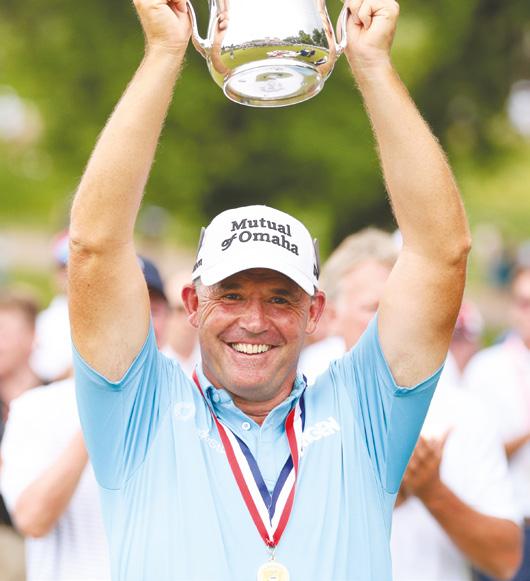
Padraig Harrington proved once again that class never fades. The 53-year-old Irishman captured his second U.S. Senior Open title with a composed final-round 67 at The Broadmoor, edging Stewart Cink by a single shot to lift the trophy.
Starting the day tied for the lead, Harrington wasted no time taking control, rolling in four birdies on the front nine. Despite the altitude and firm greens that challenged the entire field, he kept mistakes to a minimum and held his nerve

down the stretch. His final total of 11-under-par was just enough to seal the win and add another highlight to a career already packed with major moments.
“This validates all the hard work I’ve put in,” Harrington said. “You never know how many more chances you’ll get, so to come out on top again feels very special.”
The victory comes nearly two years after Harrington’s first Senior Open triumph and marks his
French golf fans have plenty to cheer about after a superb week on the DP World Tour that underlined the country’s growing strength in the professional ranks. Adrien Saddier claimed his maiden DP World Tour title with a composed victory at the Italian Open, while Martin Couvra capped an unforgettable performance by finishing runner-up.
Saddier, who has spent several seasons grinding his way up from the Challenge Tour, held his nerve brilliantly over the closing stretch at Adriatic Golf Club Cervia. A flawless final round of 67 sealed a two-shot win, proving he has the game — and the mental toughness — to
belong among Europe’s elite.
Hot on his heels was the 21-year-old Couvra, whose fearless approach all week showcased why many believe he’s one of France’s most exciting prospects. The young left-hander rattled in birdies in bunches and looked right at home in the heat of Sunday contention.
With Victor Perez already established as a Ryder Cupcalibre talent, Saddier’s breakthrough and Couvra’s rapid rise hint at a new wave of French contenders ready to make their mark.
“French golf is in a great place,” Saddier said after lifting the trophy. “There’s a lot of belief in this generation, and we’re pushing each other to get better.”
tenth PGA Tour Champions title. It also extends a remarkable run of form that’s seen him become one of the most consistent forces in senior golf.
Cink made a late push but couldn’t quite close the gap, settling for second place. For Harrington, though, the week was all about embracing the competition and enjoying the challenge.
“This is why we still play,” he added with a smile. “There’s nothing like being in contention on Sunday.”



The PGA Tour has ushered in a new era by appointing Brian Rolapp— best known for shaping the NFL’s media empire—as its first-ever Chief Executive Officer. Rolapp steps into the role this summer, overseeing both PGA Tour, Inc. and PGA Tour Enterprises, in what many see as a bold move to modernise the Tour’s commercial strategy and global reach.
The decision followed a unanimous vote from a six-person search committee that included heavyweights like Tiger Woods, Adam Scott, and outgoing Commissioner Jay Monahan. Monahan, who has led the Tour since 2017, will hand over day-to-day responsibilities but remain involved on the board until the end of 2026. Rolapp comes to golf after more than two decades with the NFL, where he led negotiations on massive media rights deals with giants like Amazon, Netflix, ESPN, and CBS. He also played a key role in creating NFL+, the league’s
Gary Woodland, the 2019 U.S. Open champion and one of the PGA Tour’s most respected competitors, has been named a Vice Captain for this year’s Ryder Cup at Bethpage Black.
U.S. Captain Keegan Bradley confirmed the appointment this week, highlighting Woodland’s leadership qualities, calm demeanor, and strong rapport with today’s players.
The 40-year-old Woodland owns five PGA Tour victories, including that memorable U.S. Open triumph at Pebble Beach, where he held off Brooks Koepka to lift his first major title. He also played a pivotal role as a member of the American team that captured the Ryder Cup at Whistling Straits in 2021, bringing a steady presence in both foursomes and singles matches.
“Gary brings so much to the
table,” Bradley said. “He’s a Major champion, he’s played in the Ryder Cup, and he has a unique ability to connect with the guys. He’ll be a fantastic influence in the team room.”
Woodland’s appointment comes as he continues an inspiring return to form following brain surgery last year to remove a lesion. His resilience and dedication have earned widespread admiration across the golfing world.
“I’m truly honoured to help lead Team USA,” Woodland said. “There’s no greater feeling than representing your country, and I can’t wait to support the team in every way possible.”
With the U.S. aiming to retain the Cup on home soil, Woodland’s experience and perspective could prove invaluable when the pressure peaks in September.

direct-to-consumer streaming service. Industry insiders describe him as a forward-thinker who knows how to balance tradition with innovation—a skill set that feels tailor-made for golf’s evolving landscape.
In his first comments, Rolapp admitted he has plenty to learn about the intricacies of the sport but called himself a long-time PGA Tour fan. His immediate focus will be to build relationships with players, partners, and fans while exploring new ways to grow the Tour’s audience and revenues.
Rolapp takes the reins at a pivotal moment. The Tour has just restructured its schedule and secured a $1.5 billion investment from Strategic Sports Group, all while navigating the ongoing fallout from the LIV Golf disruption. With fresh media rights negotiations looming before the current deals expire in 2030, there’s little doubt Rolapp’s NFL experience will be put to the test.


Sunday, the golfing gods intervened.
A 96-minute storm delay halted play –and perhaps rewired Spaun’s mindset.
“I needed that,” he confessed. “I closed my eyes and just kept repeating what Max [Homa] once said Tiger always did – stay in the moment.”
hey came to Oakmont expecting a Rory redemption, a Scottie sprint, or perhaps a Bryson encore. Instead, the 125th U.S. Open produced the biggest shock in Major Championship history – a fairytale victory for a man most golf fans had barely heard of.
STEP FORWARD JJ SPAUN.
A 34-year-old Californian with just one PGA Tour title to his name, Spaun ripped up the script and tore through the back nine to claim America’s national championship with a performance that was equal parts collapse, comeback and cold-blooded clutch.
Let’s not sugar-coat it – on Thursday morning, you’d have struggled to find a punter this side of the Atlantic who could have picked him out of a line-up.
By Sunday night, he was holding the trophy at Oakmont, having written one of the most astonishing back-nine stories golf has ever seen.
A START TO FORGET – THEN A STORM FROM THE GODS
Spaun began the final round like a man overwhelmed by the occasion – carding five bogeys in his first six holes on one of golf’s most punishing layouts. Oakmont doesn’t hand out second chances. But on this wild
SPARK TO FIREWORKS – THE BACK NINE OF HIS LIFE
When play resumed, Spaun was transformed.
A monster birdie at 12 reignited hope. A laser 7-iron to eight feet at 14. A 20-footer dropped on 17 to tie the lead. Then came the moment.
The 18th green. A downhill, breaking 65-foot putt for birdie – and the outright win. No business going in. But it did.
“I just hit and prayed,” Spaun said with a grin. “And then… it went nuts.” Cue bedlam from the gallery. Cue disbelief from the leaderboard. Cue shredded betting slips worldwide.
STAT ATTACK – WHY THIS WIN WAS NO FLUKE
Forget the fairytale – the numbers back him up:
• Total feet of putts made: 401.5 –best of the week.
• Birdie finish: Only player to birdie 17 and 18 on Sunday.
• One-putt percentage (weekend): Highest in the field.
• Final round 71: After a +4 start in six holes. He didn’t sneak in the side door – he kicked it down.

BIG NAMES LEFT IN THE SHADE
While Spaun soared, the stars sputtered.
Rory McIlroy rallied for a top 10, but never threatened the lead.
Scottie Scheffler looked uncharacteristically off, his irons lacking edge across back-to-back 73s.
• Bryson DeChambeau, the defending champion, struggled with Oakmont’s glassy greens and finished mid-pack.
Robert MacIntyre took solo second and summed it up best: “He was out of it… and then he won it in three holes. Unreal.”
DID YOU KNOW?
• Patrick Reed made an albatross on Thursday at the par-5 12th.
• Oakmont’s par-3 8th stretched to 301 yards on Sunday – a U.S. Open record.
• Spaun became the first player in 40 years to start a final round with three bogeys – and win.
• He’s now inside the top 30 in the world and has booked a place on the U.S. Ryder Cup team.
JJ WHO? NOW A HOUSEHOLD NAME
Make no mistake – this wasn’t a fluke. JJ Spaun out-thought, outfought, and out-putted the world’s best on the hardest course in Major golf.
The U.S. Open didn’t just find a new winner – it found a new warrior.
“I still don’t really believe it,” Spaun admitted later.
Believe it, JJ. We do now.

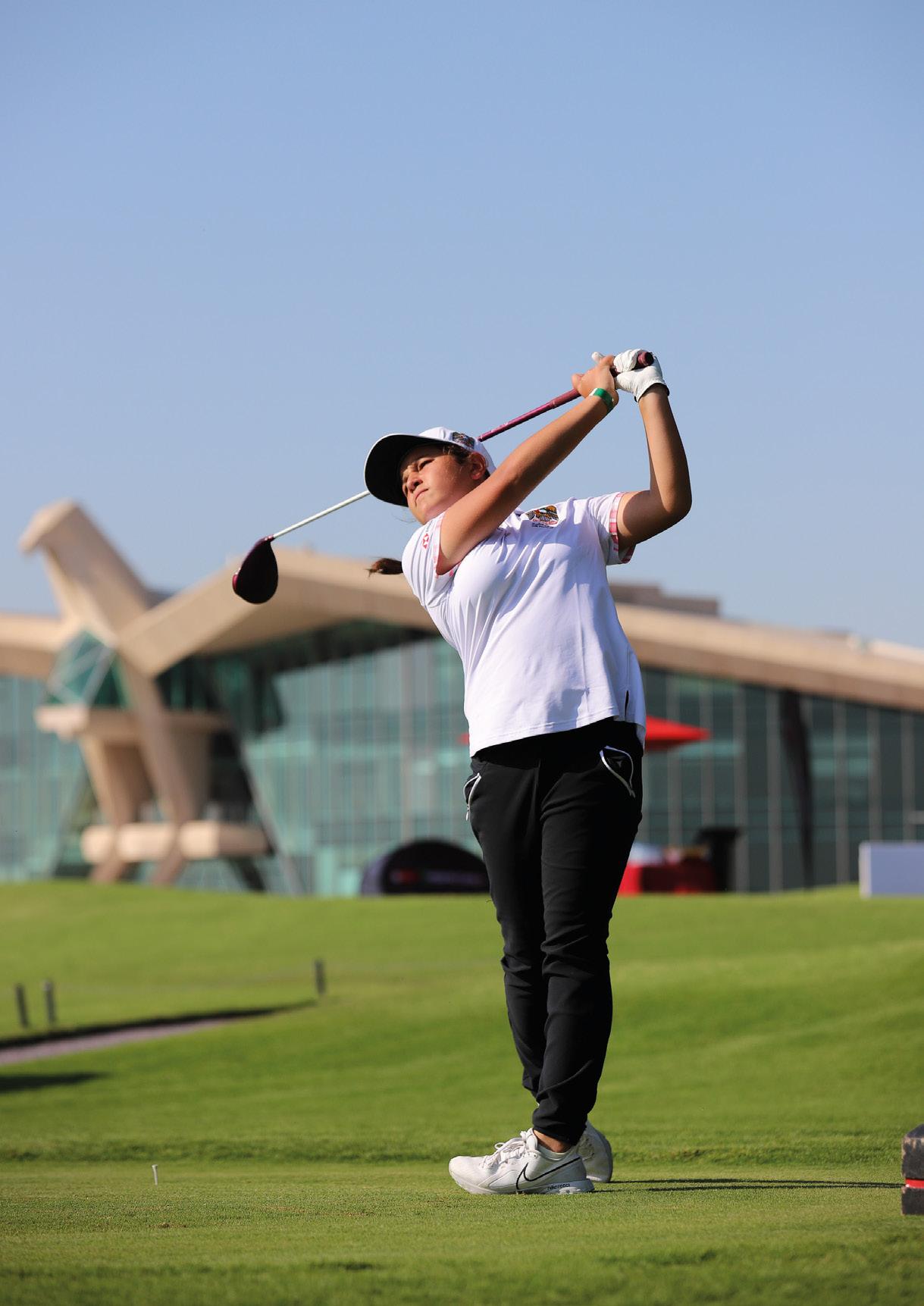


Let’s be honest—Royal Portrush isn’t your typical weekend knockabout. Perched on Northern Ireland’s wild Antrim coastline, it’s a place built on legend, laughs, and more than a few lost golf balls.
This isn’t just any golf course—it’s the only one outside mainland Britain to ever host The Open Championship. Pretty special, right? And get this: teenage Rory McIlroy absolutely shredded the course with a mind-blowing 61, leaving everyone else looking like Sunday hackers.
But Portrush isn’t just about golfing glory—there’s also plenty of drama. Ever heard of “Calamity Corner”? The clue’s in the name. It’s a par-3, 236-yard beast that eats balls for breakfast and nerves
Historic First
Royal Portrush is the only course outside mainland Great Britain to have hosted The Open Championship, first doing so in 1951.
Original Design
Harry Colt, famed for designing Wentworth and Sunningdale, redesigned Portrush in 1932, shaping it into the layout largely played today.
The Lost Holes
For the 2019 Open Championship, the club replaced its original 17th and 18th holes with two new holes from the neighbouring Valley course, now permanently part of the championship Dunluce Links.
Calamity Corner
The famously treacherous par-3 16th hole, aptly named “Calamity Corner,” is a daunting 236 yards
for lunch. Even the pros step up to this tee box wondering if they should’ve brought extra ammo.
Oh, and let’s not forget its wartime adventures. Once upon a time, the fairways were lined with anti-aircraft guns. Talk about explosive hazards!
And here’s one for the trivia fans: in 2019, Portrush waved goodbye to two of its favourite holes to spice things up for the Open crowds. Fair play, lads—it worked a treat.
Royal Portrush is golfing fun at its absolute best—equal parts prestige and playful banter. Grab your clubs and get stuck in.
of carry over a deep chasm. It’s consistently ranked among the toughest par-3s in major golf.
Northern Ireland’s Legacy
When Portrush hosted the 1951 Open, it was a historic victory for Englishman Max Faulkner—his sole major—but also marked the first time the Championship was televised, albeit briefly.
Record Crowd
The 2019 Open at Portrush attracted the highest attendance for an Open Championship outside of St Andrews, with over 237,000 spectators.
Green Speed Myths
Despite often wet conditions, Portrush greens run surprisingly fast, typically exceeding 10-11 on the Stimpmeter, and are notably firm and undulating.


A teenage Rory McIlroy set the original competitive course record of 61 in 2005 during the North of Ireland Amateur Open Championship at just 16 years old.
The lesser-known Valley Links at Portrush is considered by many locals as one of the finest second courses in the UK and Ireland, often overshadowed by its famous sibling.
Wartime Influence
During World War II, parts of the course were requisitioned by the military, used for defence purposes, and even featured anti-aircraft installations—adding to its intriguing wartime history.





In 2019, battling brutal coastal conditions, Lowry etched himself into Irish sporting folklore by clinching victory with a stunning 15-under-par total. His rounds of 67, 67, and a spectacular third-round 63 set up an iconic Sunday, as fierce weather tested every player’s resolve. Lowry described his victory as, “like an out-of-body experience. The weather was awful, but everyone was struggling. Thankfully, my caddie Bo kept me calm.” Despite that careerdefining moment, Lowry insists, “Winning the Open at Portrush was the greatest moment of my career, but I want more.”
This year’s championship is shaping up to be another memorable one, especially with the winners of the three Majors so far this season in fine form and on the hunt for more glory.

World No.1 Scottie Scheffler enters Portrush in irresistible form, having captured the PGA Championship at Quail Hollow by an impressive five-stroke margin. His season has been one of dominance, racking up three PGA Tour victories already.
“I feel great about my game and relish the challenge tough conditions present,” said a confident Scheffler. “Portrush demands your best—I’m ready.”


Rory McIlroy, meanwhile, arrives buoyed by finally completing his career Grand Slam at The Masters. Yet, the memory of his painful missed cut during the last Open held at Portrush still lingers. On his return home, McIlroy admitted, “Portrush has become my new Everest. I have unfinished business here, and I’m determined to deliver a much better performance this time around.”
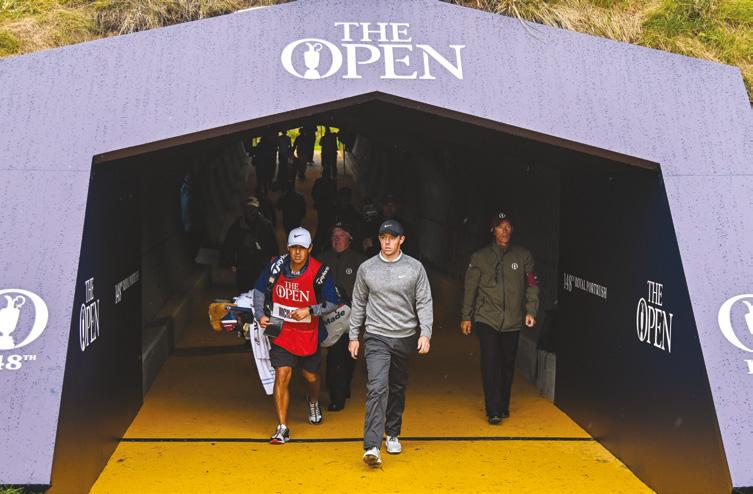

The list of contenders doesn’t stop there. Scotland’s Robert MacIntyre, runner-up at the recent U.S. Open, has quietly emerged as a formidable links player, comfortable in challenging conditions and keen to secure his first Major. MacIntyre said, “Links golf rewards creativity. I’ve always loved these conditions, and Portrush fits my game perfectly.”

JJ Spaun completes the impressive Major-winning trio, fresh from his fairytale U.S. Open triumph at Oakmont, where a 65-foot birdie putt on the final hole secured an unforgettable victory. Spaun’s confidence is understandably soaring. “Winning at Oakmont has changed everything for me,” he said. “I’m carrying that confidence into Portrush—why not dream big again?”



Beyond the formidable field, it’s the notorious Northern Irish weather that could truly dictate the narrative at Portrush. Winds are predicted to gust above 25 mph, especially around the infamous 236-yard par-three 16th, affectionately named “Calamity Corner.” Tiger Woods hit the nail on the head when he said: “Conditions here define the tournament. It can play differently every round, and adaptability is crucial.”

With Lowry looking to recreate his 2019 heroics, McIlroy chasing redemption, Scheffler out to keep his hot streak going, and Spaun eyeing another big moment, there’s no shortage of storylines. Add in a stacked field full of players getting closer to that first Major breakthrough, and Royal Portrush is set for another drama-filled week. The course is as tough and unforgiving as ever—and it’ll take something special to come out on top.



Portrush doesn’t give anything away. It demands control, guts, and the ability to grind it out when the weather turns. Lowry left his mark last time, but that was then. A new champion is about to step up—and they’ll have to earn every shot of it
Royal Portrush isn’t just a pretty links you admire from the clubhouse. It’s the kind of place where you can stripe a 3-iron, watch the wind sling it into the dunes, and spend the next five minutes wondering why you ever took up this game. Just ask Shane Lowry, who navigated every trap, bounce, and breeze in 2019 to claim the Claret Jug in unforgettable style.This is golf at its rawest. Tight fairways. Bunkers waiting like hidden snares. Greens that look welcoming until you’re chipping back and forth across them. Here’s your inside track on the holes that separate champions from the merely hopeful.
1st – Hughie’s (421 yards, par 4)
If you think you’ll ease into your round, think again. The fairway is narrow, out-of-bounds hugs the left, and your pulse will be racing before you even tee it up. Find the short grass, breathe, and get going—because the opening hole here has ended many campaigns before they’ve begun.
4th – Fred Daly’s (482 yards, par 4)
Named for Portrush’s first Open champion, this is a par 4 that demands discipline. A solid drive threaded between fairway bunkers sets up an uphill approach into a green ringed by sand. Miss your number here and you’re scrambling.
7th – Curran Point (607 yards, par 5)
One of the holes added for the 2019 Open—and a true monster. You’ll need a big tee shot that skirts the cliffs and a brave second to get into birdie range. Even laying up doesn’t guarantee an easy pitch. A hole where big hitters can pick up ground, if they dare.
8th – Dunluce (434 yards, par 4)
Another fresh face in the routing that slots in perfectly. The fairway pinches in just where you’d prefer some room, and the green sits ready to deflect anything less than a pure approach. A proper momentum-swinger if you can attack it confidently.
12th – Dhu Varren (532 yards, par 5)
This looks generous off the tee, but it’s a trap for the overconfident. A fairway bunker short of the green swallows lay-ups that drift offline, and the putting surface falls away in every direction. Plenty of birdies here in 2019—but plenty of bruised egos, too.
16th – Calamity Corner (236 yards, par 3)
The clue’s in the name. This brute played as the hardest hole during the 2019 championship, yielding just 24 birdies all week. Anything leaking right is gone forever. Step up, commit to your number, and hope the wind doesn’t change its mind mid-swing.
18th – Babington’s (474 yards, par 4)
One last examination. A testing drive and an approach that demands total focus. Lowry’s closing bogey was more than enough to trigger a homecoming celebration for the ages. For everyone else, it’s a final reminder that Portrush rewards only the bravest—and the best.

Calamity Corner (236 yards, par 3)






Rick Shiels has redefined what it means to teach, entertain and inspire golfers around the world. In this exclusive interview with Alex Gallemore, the PGA pro turned content powerhouse shares the story behind his meteoric rise, his passion for growing the game, and what keeps his videos fresh after thousands of uploads.
If you’re a golfer with a smartphone, chances are Rick Shiels has popped up in your feed, probably holding a driver, squinting at a launch monitor and telling you whether the latest £500 rocket launcher is worth the hype. He’s the everyman voice in a world of polished tour stars, a PGA pro who swapped the safety net of the lesson bay for the rollercoaster of content creation, and wound up with more subscribers than most TV golf shows could dream of.
What started in a chilly corner of Manchester, just Rick, a tripod and a hope that a few locals might book a lesson, has exploded into a global phenomenon. He’s played with the game’s giants, critiqued every club under the sun, and jetted around the world filming with LIV Golf’s biggest personalities. Yet, through it all, Rick still sounds like the lad you’d bump into on the range, just with a few million more friends along for the ride.
Let’s go back to the beginning. When you fired up that first camera, did you really think it would end up here, two and a half thousand videos, millions of subscribers and a passport full of stamps?
Not in a million years. It’s still mad to think about.
I started my YouTube career 13 years ago because I needed more people coming through the door for lessons. Back then, YouTube wasn’t a business model; it was an advertising tool. I’d make videos about grip and swing tips, and hopefully, someone would ring up and say, “I saw your video, can I book a lesson?” For a while, that was it. No revenue, no sponsors, just me trying to keep my diary full. A couple of years later, the channel started to get a bit of traction, and I realised there might be something bigger going on. I thought, Hang on… there’s potentially no ceiling to this. That was when it clicked: this could be more than a side hustle.
You’ve literally travelled the world, camera in hand. How surreal has that been?
Incredible. I’ve been to the States more times than I can count: Dallas, Orlando, San Diego. Last year, I travelled to Adelaide, Miami, Jeddah and Riyadh. You find yourself on the tee thinking, How did I get here? And then you just crack on and do your job. That’s what’s so brilliant about golf; it opens doors you never even knew existed.
You’re no stranger to Dubai. What is it about this place that keeps you coming back?
Dubai’s just got it all, hasn’t it? Great golf courses, unreal weather (most of the year), and that big, welcoming clubhouse culture. Every Christmas and New Year, my family and I head over; we’ve been doing it three or four years straight. We’ll play a bit of golf, take the kids to Topgolf, have a few nice meals. Night golf in particular is something I think the rest of the world could learn from. The Faldo Course under the floodlights is spectacular and

Topgolf Dubai, wow. That place is colossal. You’ve got non-golfers, families, serious players all in one space. It’s the most inclusive golf environment I’ve ever seen. We could do with more of that back in the UK, where golf still feels a bit stiff sometimes.
If you had to be critical, anything you reckon Dubai hasn’t quite nailed yet?
If we’re being picky, I still think golf globally lacks that middle step between the range and 18 holes. Imagine six-hole courses, just an hour of golf. You get your fix without giving up your entire day. For beginners, it’s less intimidating. For established golfers, it’s a way to keep sharp. Dubai is already leading the charge in innovation, so if anywhere’s

going to build a network of short courses, it’ll be here. They’d probably do it in style too, with floodlights, music playing, great food and drink.
Let’s say you’re teeing it up out here; would you set up your bag differently for Dubai’s conditions?
One of the skills in Dubai is launching the ball high; it’s not that windy, and the greens are firm. If I was playing out there tomorrow, I’d probably bin my three-iron and put in a five-wood or maybe even a seven-wood. Those clubs have exploded in popularity because they’re so easy to launch. You need the height to stop the ball. Unlike links golf, you can’t bounce it up. And if I’m being honest, part of the fun is tinkering. The launch monitor numbers, the shaft swaps; I still love it as much now as when I started coaching.
You’ve played alongside some serious names, Rahm, Hatton, Fleetwood. What’s your first thought when you step onto the tee with guys like that?
Just how good they are. Different gravy. I’ve known for a long time the gap between club pros and tour players. I remember turning pro at 18, trying to chase the dream. I shot one or two under in a local event and thought, Right, that’s me, winner’s speech ready. I lost by six. That was the moment I realised, I don’t have that gear. Since then, I’ve spent time filming with some of the best in the world. When you watch Tommy Fleetwood carry his own bag in December, hitting it like it’s the middle of summer, you understand how special they are.
You’ve mentioned Niemann’s bunker play before; what makes it so good?
Honestly, it’s filthy. Every time he’s in the bunker, you think he’s dead. Then he pulls off some ridiculous flop shot to three feet. I reckon Pete
Cowen must take a lot of credit. He’s probably one of the most influential coaches in the world, and you can see his fingerprints on their wedge play.
Is there one player who struck you as being cut from a different cloth?
Rahm. No question. He is an animal. You see it in everything he does. He wants to win absolutely everything; it doesn’t matter if it’s a Major or rockpaper-scissors. You can feel that competitiveness pouring out of him. It’s the same with Tyrrell Hatton and Bryson. All the top players are wired the same way. They hate losing more than they love winning. That’s the biggest difference between elite tour players and everyone else. The talent is obvious, but the mindset, that refusal to lose, that’s what sets them apart.
You’ve made two and a half thousand videos. How do you keep it fresh when everyone’s tracking your numbers?
You’ve got to be relaxed about it. I know what I’m good at, and I know what I enjoy making. These days, it’s not always about chasing the biggest numbers. Sometimes, the most satisfying videos are the ones I just really enjoyed filming. Sure, the metrics matter, but when I meet golfers at events, the appreciation is worth more than any analytics dashboard. And look, when I started, there were three golf channels. Now there are thousands. It’s like TV; once upon a time you had BBC1, BBC2 and ITV. Now you’ve got Netflix, YouTube, TikTok, content everywhere. Your audience spreads thinner, but if you keep making good stuff, people will watch.
Last one: technology. Are we running out of ways to squeeze extra distance out of drivers? It’s definitely slowed down. You’re not getting 10 yards a year anymore. But you still see gains, half
“
I’VE KNOWN FOR A LONG TIME THE GAP BETWEEN CLUB PROS AND TOUR PLAYERS. I REMEMBER TURNING PRO AT 18, TRYING TO CHASE THE DREAM”.
a yard here, a yard there. I did a video recently comparing 20 years of TaylorMade drivers. Even then, you could see a steady improvement. I don’t think we’re at the end yet. The big brands are still innovating. As long as golfers want that edge, there’ll be something new to talk about.





Shane Lowry’s golf swing is like a pint of the black stuff, smooth, rich and deceptively potent. In 2025, the Irishman has been as reliable as ever, ranking fourth in strokes gained approach and hitting over 72% of greens in regulation. That silky tempo? It’s not just for show—it’s the secret sauce behind his precision with the mid-irons and that trademark soft fade. Whether he’s flighting wedges under the wind or flushing a 4-iron to a tucked pin, Lowry’s swing proves you don’t need to look textbook to be world-class. It’s all about rhythm — and a healthy dose of self-belief.









Shane is such a natural player who can comfortably control the shape and trajectory of his ball. Coaches often talk about the ability of a player who can hit all nine shot shapes/ windows and Shane can certainly do that with ease.
He focusses on good setup rather than the swing and I feel that’s what amateurs can learn most from – his naturally instinctive movement.
Shane displays some characteristics which may go against the grain when you listen to modern-day coaching and I love that.
His full swing characteristics such as narrow stance, left knee and club head working in, early wrist set, arms lifting, club face open and across the line, left wrist cupped, hips staying closed are points you’re maybe trying to correct in your own swing but sometimes thats not what’s needed!
Maybe it’s better to check your basic setup. Posture, ball position, alignment, grip and take it from there. Follow Shane’s example and allow the body and arms to swing the natural weight of the club with great rhythm and timing with no rush to strike the ball from the top. Develop an unrestricted, free-flowing action first then start to look at how you can improve things from there.
Written by Stephen DeaneHead International Development Coach for Dubai Golf
Stephen is an ambassador for Dubai Golf and coaches at their wonderful array of facilities whilst in Dubai. Stephen also spends a proportion of his time developing professionals, amateurs and VIPs internationally.
He has a passion for coach education and sharing knowledge and ideas with his colleagues and students.




1. Shane sets up with a narrow stance with his arms hanging naturally under his shoulders. He implements a strong left hand grip.
2. He keeps his head still as he lets his left knee work in and right leg work back to start his swing. He allows the club to work in, similar to the great Sam Snead.
3. The right leg straightens further allowing his hips and chest to open naturally as his wrists set early
4. He continues to allow his chest to open as he freely allows his arms to lift.
5. At the top he’s created a superb chest turn with very relaxed arms similar to Fred Couples. He’s maintained the natural cupping in his left wrist due to his strong grip, allowing the face to stay open
and move slightly right of target.
6. In transition he moves his lower half beautifully to the left, not allowing his hips to open early as his arms naturally fall.
7. As his arms continue to fall back in front of him, he stays closed to the target and, again, doesn’t allow his body to open early.
8. Again, he hasn’t excessively opened his hips as he approaches the ball – he simply continues to allow the arms to drop and stay relaxed while the club moves into a beautiful 45 degree angle with his shoulders still closed to his target.
9. Impact: his upper body stays well behind his lower body, allowing lots of time for the club face



to square up. You can see how square his shoulders and club face stay well through impact as his arms beautifully return under his shoulders, just like in his setup.
10. There’s no stall in the motion as his right side continues to follow his free-flowing arms as his left elbow bends.
11. He continues to allow his right side to move through as his arms work beautifully around his body.
12. A full arm and body release as he balances perfectly on his left heel and right toe, showcasing an unrestricted and free-flowing action of both his arms and body through the ball.

Ping’s i-series irons have long been the go-to choice for Tour players and accomplished amateurs who want that elusive blend of a compact head shape with just enough forgiveness to keep the big numbers off the card.
The likes of Viktor Hovland and Sahith Theegala still have trusty i210s tucked into their bags—a testament to how good Ping’s players’ cavity-back irons have been over the years.
With the new i240 irons, Ping is clearly aiming to keep that loyal fanbase engaged while nudging the design forward.
Compared to the clean, understated look of the i230s, the i240s introduce some noticeable visual changes, including a section of exposed carbon fibre just under the topline and a pop of red paint fill in the “i” badging. While the look is more modern, it’s likely to split opinion among purists who prefer a simpler aesthetic.
The head shapes remain reassuringly familiar, sitting somewhere between the current Blueprint S cavity-back and the i230. For players who like to blend sets, it’s an easy progression: i240 long irons for extra launch and forgiveness, then Blueprint S or even the muscle-back Blueprint T in the scoring clubs.
Where these irons really shine is feel. Ping has used an injection-moulded elastomer to create a softer impact sensation and a more muted sound— noticeably improved over previous generations. It’s subtle, but when you catch a pure strike, you’ll know it instantly.
Ping claims the i240 delivers an 11% tighter dispersion over the i230, however we didn’t have an identical-spec i230 set on hand to confirm that number. What we did see in testing was a clear performance bump in the long and mid irons. From the 5-iron through the

7-iron, shots launched higher and carried farther with a stronger, more penetrating flight—ideal if you want to hold greens from 180+ yards out.
Some of that forgiveness comes from clever weight savings. The cavity badge is 8.5 grams lighter, and Ping has redistributed that weight to boost MOI. On the course, the result feels confidence-inspiring—especially on slight mishits.
LOFT OPTIONS
One of the standout features is Ping’s honest approach to lofts. Instead of sneaky jacked numbers, you can pick between three configurations:
Standard: 7-iron at 33°
• Power Spec: 31.5°
Retro Spec: 35°
It’s refreshing to see a brand give golfers the flexibility to gap their set properly, rather than playing a “7-iron” that’s effectively a 5.
The stock shaft is the Nippon N.S. Pro Modus Tour—a mid-launch option that will suit most players in this category. As always, we’d recommend getting custom-fitted, especially given the variety of loft and lie options on offer.
VERDICT
If you loved the i210 or i230, the i240 is a worthy successor with more forgiveness and a softer feel. While some may find the cavity design a touch cluttered compared to the oldschool clean lines, the performance gains are undeniable.
PROS:
• Excellent forgiveness and consistency
Soft feel and pleasing sound
• Sensible loft options
CONS:
• Aesthetics may divide
OPINION
For better players who want a workhorse iron that still gives them help on off-centre hits, the i240 deserves a serious look. Just be prepared to spend a bit of time deciding which loft spec fits your game—and whether you can live with the racier cosmetic touches.





By Alex Gallemore



Both models are centre-shafted, which sets the tone for their performance. If you’ve struggled with twisting or inconsistent face rotation, these are designed to keep everything square through impact. of gravity to help keep the face square, and the built-in 3.3 degrees of forward shaft lean encourages a natural forward press. For many players, this will immediately simplify setup and reduce face rotation without any conscious manipulation. Three shaft weights: SL 90, 140, and 180, let you match the putter’s balance to your preferred length and feel.
I’ll admit it: I’m partial to a larger mallet. There’s something reassuring about standing over a putter that looks like it was designed to never twist. And that’s exactly the sensation you get with the Max Stripe in particular.
One of the standout qualities of this range is the sheer effortlessness of keeping the face square. The zero-torque design does exactly what it promises: it all but eliminates the wobble that can sneak in when nerves strike. That stability is most noticeable on shorter putts. Inside 10 feet, it feels as though the head is on rails, just point and roll. Even on longer efforts, the consistent speed and directional control help take some of the guesswork out of lag putting.
The caveat? The standard lie angle is fairly upright. If you prefer your putter to sit flatter, you might not unlock the full forgiveness potential without an adjustment.








VERDICT: WHICH ONE SHOULD YOU TRY?
After a few rounds testing these putters, I kept coming back to the Max 1. For me, the simpler alignment suited my eye and felt less busy behind the ball. But if you appreciate a more prominent visual aid, the Max Stripe makes lining up almost automatic. Both models share the same DNA: enormous stability, a buttery-soft feel, and an ultra-consistent roll. If you’re the kind of player who struggles with face rotation, or if you’ve simply grown tired of inconsistent distance control, these
are well worth a look. They’re not small, and they’re not subtle. But if you can embrace the size, Odyssey has delivered two of the most confidence-inspiring mallets on the market today.
Whether you’re replacing an older Square 2 Square or curious to see how they compare to the L.A.B. DF3, these new Ai-One putters deserve a place on your shortlist. They’re proof that sometimes, bigger really is better and that Odyssey still knows exactly how to make a putter that performs under pressure.




Photography: Alex Leyno
Let’s be honest—most golfers wouldn’t fancy a couple of pins in their hips before they’d even cracked adulthood, or sitting in a wheelchair with your clubs taunting you from the foot of the bed. But Stuart Taylor isn’t most golfers. He’s the kind of bloke who’ll take that sort of setback, dust himself off, and, eventually, pinch Darren Clarke’s course record for good measure.
Today, Taylor is the affable General Manager of ProSports International—the UAE’s heavyweight when it comes to golf equipment, club fitting, and pretty much anything else that helps you stripe it further than your mates. But if you think it was all sunshine and tailor-made shafts from the get-go, you’d be mistaken.
When we caught up with Stuart, he shared the story of a journey that started in Lancashire, detoured through hip surgeries and the pro circuit, and landed him here in Dubai—where he’s been grafting, innovating, and helping local golfers level up for nearly 15 years.
Grab a coffee (or something stronger), because this is the tale of how one lad’s love of golf never dimmed—no matter how many curveballs life (and the odd dodgy lie) threw his way.
“WHEN I STARTED, WE DIDN’T HAVE THE LEVEL OF TECHNOLOGY WE DO NOW,” STUART SAYS. “TRACKMAN WASN’T EVERYWHERE, AND DYNAMIC FITTINGS WERE ONLY JUST BECOMING MAINSTREAM.”
Ask any golfer to list their proudest moments, and you’ll often hear about that one glorious day when every putt found the middle of the cup. But for Stuart, his greatest memories started as part of something bigger.
“Proudest achievement as an amateur?” he laughs, weighing up a long list of possibilities. “I’m going to go down the team route on this one rather than myself.”
See, back in the day, Stuart was an absolute force for Lancashire county golf—the sort of reliable team man every captain dreams of. But it was one particular campaign that stuck with him.
“We won the English County Finals to make us the best county team in the country,” he says, with a grin that suggests it still gives him goosebumps. “We beat Yorkshire at Hexham in the northern section and then went on to Longcliffe in Loughborough for the final. Myself and three of the lads all came back from losing positions on the front nine to win our matches. That was pretty incredible.”
It wasn’t a one-man show, and that’s precisely why he loved it. “It was an amazing team,” Stuart says, proudly. “The county set-up had been running for ages. To get over the line and call ourselves champions—that meant everything.”
Of course, Stuart didn’t hang up the spikes after county golf. He earned his PGA stripes and had
a good go at the pro ranks—an experience that gave him ultimate respect for tour players and their relentless slog.
“Looking back, I probably went out on tour a bit young,” he admits. “You see how much travel is involved—how demanding it is mentally and physically. It’s not for everyone.”
Still, there were moments of brilliance. One that stands out involved none other than Christy O’Connor Sr., a Ryder Cup icon, and, unwittingly, Darren Clarke.
“I won my pro-am and shot a course record at Island Golf Club,” Stuart says, lighting up. “I got to take the trophy from Christy O’Connor Sr.—what an absolute legend. And to know I’d taken the record off Darren Clarke? That was special.”
He makes it sound almost casual—like breaking a course record is just something you do on a Thursday. But it’s that modesty that makes Stuart such good company.
After that stint of tournament golf, Stuart faced a crossroads: keep grinding out life on the road, or find a way to channel his passion closer to home.
“I’d always had this itch to teach,” he recalls. “I wanted to pass on everything I’d learned—from elite amateur golf to playing pro—to the next generation.”
When some of his friends moved to Dubai, he paid attention. The city was growing, the courses were thriving, and there was a real hunger for expertise.
“I could see opportunity here,” he says. “And I knew I could help people—whether it was juniors picking up a club for the first time or better players wanting to get to the next level.”
It didn’t take long before Stuart’s path crossed with Sheikh Saeed Bin Hasher Al Maktoum at ProSports International. But don’t think for a second he walked straight into the General Manager’s chair.
“He made it clear he wanted me on board,” Stuart says. “But he also made it clear I’d be starting at the bottom. No shortcuts.”
And start at the bottom he did—lugging bags, learning the nuts and bolts of retail, and studying every detail of equipment performance.
Over the next 14 years, he climbed every rung of the ladder.
“When I started, we didn’t have the level of technology we do now,” Stuart says. “TrackMan wasn’t everywhere, and dynamic fittings were only just becoming mainstream.”
But he loved the challenge. ProSports’ philosophy—to make sure every golfer walks away with the right kit for their game—matched his own perfectly.
“It’s been amazing to watch Dubai golfers embrace





the idea that the right club, shaft, ball—even the right pair of shoes—can completely transform their game,” Stuart says. “We’ve had people come back and say, ‘I’m hitting it 20 yards further,’ or ‘I finally got rid of my slice.’ That’s what it’s all about.”
And it’s not just the single-figure handicappers who get his attention. Weekend warriors, new golfers, and juniors all get the same level of care.
“Whatever level you’re at, you deserve the best advice and the right equipment,” Stuart says. “Those incremental gains are what keep people excited about golf.”
The story might sound like a steady upward arc—but there’s one chapter that tested Stuart in ways most golfers can barely imagine.
When he was still a teenager—flying as a junior—he developed a severe issue with his hips. The solution? Two pins in each hip.
“I wasn’t allowed to walk,” he says, quietly. “I had to live downstairs, in a wheelchair, looking at my golf clubs every day.”
It was the sort of nightmare that could break a lot of people. But for Stuart, it was motivation.
“Those clubs sitting there were my inspiration to get better,” he says. “When I finally got back
on my feet, I spent six months just chipping and putting. I wasn’t allowed to make a full swing.”
Eventually, he returned to the course. What happened next was the ultimate vindication.
“A couple of games later, I shot the course record at my home club,” Stuart says, almost sheepish. “After worrying whether I’d walk again, to play like that—it was massive for me.”
Fifteen years is a long time in any city, but in Dubai—where everything evolves at warp speed—it feels even longer.
“It’s changed so much since I arrived,” Stuart says, looking around. “Back then, there weren’t as many courses, and the approach to fitting and coaching wasn’t as sophisticated. Now, you’ve got world-class facilities everywhere.”
And he’s had a front-row seat for it all.
“What I love about Dubai is how open people are to improving,” he says. “Golfers here really want to learn, to get the best out of themselves. And there’s such a brilliant mix—from local Emirati players to expats who’ve played all over the world.”
Does he ever see himself heading back to the UK? He pauses for a moment.
“Dubai feels like home now,” he says. “I’ve built my career here, I’ve watched the golfing landscape transform, and I’ve had the chance to grow alongside it.”

“A
COUPLE OF GAMES LATER, I SHOT THE COURSE RECORD AT MY HOME CLUB. AFTER WORRYING WHETHER I’D WALK AGAIN, TO PLAY LIKE THAT—IT WAS MASSIVE FOR ME.
Spend five minutes talking to Stuart Taylor, and it’s clear: this is a man who lives and breathes golf.
From county titles and course records to helping thousands of players find that magic club, he’s done it all—without losing the humble, grounded love of the game that first got him hooked.
“Golf’s given me so much,” he says, smiling. “It’s taught me resilience, patience, and how to look forward instead of back.”
And if you’re ever in doubt that the right equipment can make a difference, pop into ProSports International. Odds are, Stuart will be there—ready to hel0p you find your next secret weapon.
So here’s to the man who turned adversity into achievement, who swapped Lancashire drizzle for Dubai sunshine, and who still gets a buzz from seeing golfers play their best. Stuart Taylor: a reminder that in golf—as in life—it’s how you bounce back that counts.


When it comes to elite English golf, Surrey is in a class of its own. Tucked just southwest of London, this glorious patch of countryside isn’t just a posh commuter belt—it’s golfing royalty.
With its golden heathland turf, towering pines, and some of the most historic clubhouses in the country, Surrey’s premier quartet of Wentworth, Sunningdale, Royal

Mid Surrey, and Worplesdon is the kind of line-up that makes even the most seasoned golfer weak at the knees.
Whether you’re plotting a weekend escape or weaving a few dream rounds into a trip to the capital, these four gems offer everything from Ryder Cup pedigree to under-the-radar brilliance. Here, you will walk in the footsteps of legends, tackle bunkers with names, and quite possibly
enjoy the best halfway-hut sausage sandwich in Britain. And when the clubs are away, Surrey’s allure continues with riverside pubs in Richmond, Michelin-starred menus in Windsor, and luxury hotels with spas that can soothe even the sorest of swings. This is a golfing getaway with serious flair. Four clubs. One county. Endless reasons to tee it up. Welcome to Surrey’s fairway elite— where great golf comes with a side of style.

If you’re ticking off iconic English courses, Wentworth is non-negotiable. Nestled in the exclusive enclave of Virginia Water and home to the DP World Tour headquarters, this grand estate offers three championship layouts, but it’s the formidable West Course that commands the spotlight. As the long-time host of the BMW PGA Champion-
ship, this is a serious test of golf with an unimpeachable pedigree. Originally designed by the master architect Harry Colt and later toughened by Ernie Els, the West is a tree-lined brute that demands strategy, shot-shaping, and unwavering composure. The famous closing stretch—culminating in the dramatic, risk-reward par-5 18th—is
pure theatre, framed by the imposing clubhouse and watched by thousands during tournament week. Beyond the golf, Wentworth oozes exclusivity. It’s posh, polished, and pricey, but for the travelling golfer, a round here is a tee time with history itself.

Few clubs in the world blend charm, history, and sheer quality quite like Sunningdale. With two world-class courses—the Old, a Willie Park Jr. and Harry Colt classic from 1901, and the New, a 1923 creation by Colt and Tom Simpson—this is English heathland golf at its absolute finest. Both
tracks are perennially ranked among the best in the UK, and for good reason. The Old is a picturesque masterpiece of rolling fairways and springy turf that possesses an almost cinematic aura. The New is slightly more rugged, with bolder bunkering and tighter angles, but every bit as magnificent. To play
both in a single day is to experience golfing bliss. Everything at Sunningdale feels understated and elegant, from the legendary halfway hut sausage sandwich to the warm, genuine welcome. It’s the kind of place where time slows down, and the game is played as it was meant to be.


Set within the tranquil bounds of Richmond’s Old Deer Park, just minutes from central London, Royal Mid Surrey offers a unique marriage of royal heritage and modern accessibility. With two 18-hole courses—the JH Taylor and the Pam Barton—the club is steeped in history, proudly bearing its royal patronage and the name of five-time Open Champion JH Taylor. While it may lack the sprawling drama of its heathland neighbours, the club thrives
on tradition and charm. The JH Taylor Course is the star attraction: a beautifully maintained, parkland test that rewards intelligent course management and a sharp short game over brute force. The recently modernised clubhouse is a treasure trove of memorabilia, and the service is impeccable. A stone’s throw from the Thames, it feels a million miles from the city rush, making it the perfect choice for a relaxed, refined round close to the capital.

Often overlooked in favour of its more famous neighbours, Worplesdon is a hidden gem that quietly delivers one of Surrey’s most authentic and enjoyable golfing experiences. Designed in 1908 by J.F. Abercromby, it’s one of the area’s most unspoiled heathland layouts—blissfully playable, endlessly charming, and refreshingly unpretentious. The routing flows effortlessly through corridors of pine and heather, with clever bunkering and natural
contours providing the challenge. This is a thinking player’s course where precision outweighs power and every hole presents a distinct and memorable personality. The collection of par-3s is particularly outstanding. Worplesdon also scores high for its atmosphere; the clubhouse is cosy, the welcome is genuine, and the sense of tradition is strong without ever being stifling. It is pure golf without the fanfare—and all the better for it.
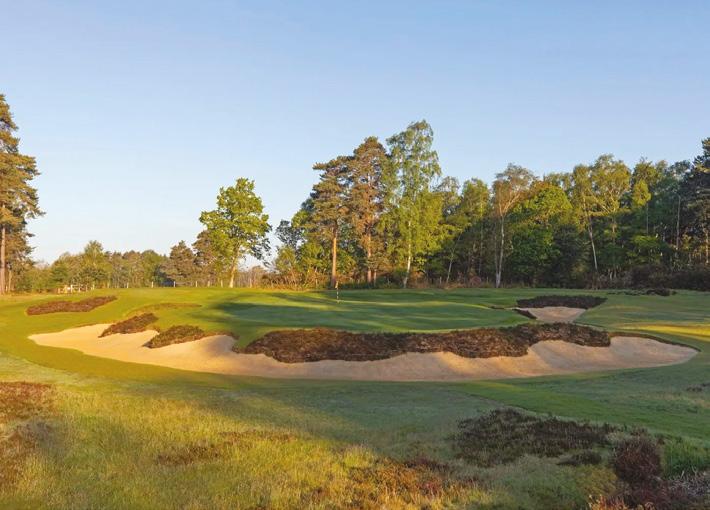

For those playing Wentworth or Sunningdale, basing yourself in Virginia Water or Ascot offers a touch of countryside luxury. The Coworth Park in Ascot delivers five-star grandeur with a modern British restaurant, a world-class spa, and even its own polo fields. For something cosier, the Royal Berkshire Hotel mixes classic country house vibes with easy access to the courses. Foodwise, The Loch & The Tyne in Old Windsor is a must-visit; run by Michelin-starred chef Adam Handling, it’s a refined take on British pub dining with sustainability at its heart. Near Sunningdale, Pennyhill Park is not just a luxe hotel—it’s home to The Latymer, a sublime Michelin-starred finedining experience.
If you’re playing Royal Mid Surrey, stay nearby in Richmond. The Bingham Riverhouse blends boutique comfort with stunning riverside views, while the Richmond Hill Hotel offers Georgian elegance within walking distance of the park. After your round, head to The Ivy Café Richmond for upscale brasserie fare, or unwind with a pint at The White Cross, a historic pub that spills out onto the Thames on sunny evenings.
THE SIMULATOR SCENE: LONDON’S DIGITAL FAIRWAYS
For After a day on Surrey’s classic courses, the modern golfer’s evening entertainment is found in London’s booming indoor golf scene. Forget the basic simulators of the past; today’s venues offer hyper-realistic experiences that are perfect for a post-round wind-down or some serious techdriven practice.
For the ultimate in realism, the standout destination is The Golf Rooms in Brentford. Setting itself apart from the city-centre crowd, its focus is on replicating the true physical challenge of the game using revolutionary GolfZon technology. Here, the simulator bay itself transforms to match your position on one of over 200 meticulously mapped courses. The patented moving swing plate adjusts the floor beneath your feet to create genuine uphill, downhill, and sidehill lies, forcing you to adapt your stance just as you would on the course Furthermore, if your shot lands in the rough or a bunker, you play from a multi-surface hitting mat with different textures that realistically affect your shot, a feature unique to the GolfZon system.
While The Golf Rooms champions physical realism, other top-tier alternatives are sprinkled around the capital. For the data-driven player, CaddiClub offers a network of premium members’ clubs in locations like Chelsea and Fulham, using tour-proven TrackMan technology to deliver precise analytics on every swing. For those seeking a more lively, entertainment-focused experience, Pitch is the go-to for “social golf.” With venues in the City and Soho, it combines TrackMan simulators with a buzzing bar atmosphere, DJs, and fun, accessible games perfect for groups of all skill levels.
From the timeless allure of its heathland courses to the cutting-edge technology of its urban simulators, the combination of Surrey and London offers a golf experience that is truly unparalleled. It’s a journey that respects the rich heritage of the game while embracing its exciting future. Whether you seek the stern examination of a championship layout or the vibrant energy of a social golf lounge, this corner of England delivers on every front, cementing its status as the ultimate getaway for the discerning golfer.





If there’s a European destination that knows how to pair top-drawer golf with a touch of coastal glamour, it’s Vilamoura. On the Algarve, championship courses sit side by side with golden beaches, smart hotels, and a marina scene that buzzes long after sunset.
From the cliff-top spectacle of Pine Cliffs to the stately avenues of The Old Course, every fairway has its own personality—and a habit of sneaking under your skin. You’ll find slick greens, endless sunshine, and the kind of relaxed atmosphere that makes every round feel more like a reward than a challenge.
Between tee times, you can fill your days with seafood feasts, cool Atlantic dips, and a glass (or two) of vinho verde as the sun goes down. It’s golf, but not as you know it—more playful, more scenic, and a whole lot more fun.
If you want golf with a side of jaw-dropping scenery, Pine Cliffs delivers in spades. Perched on rugged red cliffs above the Atlantic, this isn’t just a round—it’s a sightseeing tour with a scorecard. The course is shorter than its Vilamoura siblings, playing to around 6,000 yards, but don’t be fooled—accuracy is everything here. Fairways are tight, greens are wellprotected, and the ever-present ocean breeze has a habit of swatting your ball off line just when you’re feeling confident.
The signature hole, the 6th, known as the “Devil’s Parlour,” is a par-3 that will test your nerve and your club selection. You’ll stand on the tee, heart thumping, staring 197 yards over a gaping chasm to a tiny green clinging to the cliffs. Hit it pure and you’ll
remember it forever. Miss it, and you’ll be teeing up again—hopefully with your dignity intact.
The rest of the layout is a mix of pretty doglegs and gently rolling terrain, lined with pine trees and dotted with flashes of colour from the landscaped gardens. It’s the perfect warm-up course to ease into a Vilamoura trip—short on yardage, big on character, and guaranteed to fill your phone with photos. If you fancy combining golf with a luxury resort stay and a dip in the Atlantic after your round, this is the place to start.
Laranjal is where you go when you’re ready to get serious. Originally an orange grove (you’ll still spot the odd tree), it’s now an inland masterpiece that makes you think on every tee box. It’s the youngest of the Quinta do Lago courses but arguably the
most distinctive, with wide fairways that lull you into swinging freely before revealing devilish bunkering and tight landing areas that punish anything offline.
This is a track that rewards course management over brute strength. Par-4s like the 7th, with its dogleg left and heavily bunkered green, demand precision from tee to flag. The par-3s are all postcard material, framed by pine trees and peppered with hazards that make club selection crucial. Miss the green and you’ll be relying on your short game to salvage par— assuming your confidence isn’t already shaken.
Greens here are large and undulating, rolling fast and true. If you struggle with pace, prepare to rack up a few three-putts. But when you do hole a long one, it feels twice as satisfying. Laranjal doesn’t shout about itself—it just quietly dishes out a superb, fair test. It’s pure, strategic golf with immaculate



conditioning and a peaceful vibe that’s a welcome contrast to the busier courses nearby. Play it once and you’ll want another crack straight away.
If you like your golf modern, manicured, and just a little bit flashy, Quinta do Lago North will suit you to a tee. Redesigned by Paul McGinley in 2014, this course was given a million-euro facelift that turned it into one of the Algarve’s most compelling layouts. Fairways are generous off the tee, tempting you to pull driver on almost every hole—but don’t get too cocky. The real challenge here lurks around the greens.

sense of place, with umbrella pines lining the fairways and glimpses of the marshland that gives the area its unique character. The conditioning is always top-notch, and service matches it stride for stride. It’s a place to hit it long, think it through, and enjoy every challenge. For many, it’s the Algarve’s best all-rounder.
layouts, the Old Course doesn’t rely on gimmicks or forced drama. Instead, it asks you to shape shots, think ahead, and accept that the trees are very much in play if you stray.
Holes like the 4th and 13th are classics—narrow doglegs that reward a confident tee ball and punish hesitation. The greens are modest in size but beautifully contoured, and if your iron play is dialled in, you’ll have chances to score. But stray offline and you’ll be hacking out sideways more often than you’d care to admit.
Despite its vintage, the course has been sympathetically updated over the years, maintaining its soul while improving conditioning. The Old Course doesn’t scream for attention—it simply delivers timeless, satisfying golf that never goes out of style.

STAY:
Grande Real Villa Itália Hotel & Spa – Just a chip shot from the marina, this elegant retreat blends Mediterranean charm with luxe spa treatments. Perfect for easing those pre- or post-round aches.
Tivoli Marina Vilamoura – Sleek, stylish, and right in the action. With harbor views and rooftop cocktails, unwind in sophistication after your 18th green.
Crowne Plaza Vilamoura – A favourite among golfers, this contemporary hotel sits right on the beach. Expect spacious rooms, a fantastic spa, and a pool area made for lazy afternoons after your round.
EAT:
O Marisco – Fresh seafood with a seabreeze view. From buttery garlic prawns to grilled sea bass, every plate celebrates the Atlantic.
The Fisherma n – A marina favorite, this laid-back spot nails casual fine dining. Try the cataplana—a traditional seafood stew that’s as picturesque as the view.
Bunkering is bold and cleverly positioned, with large expanses of sand ready to swallow anything less than pinpoint approaches. The greens themselves are vast, multi-tiered puzzles that will test your imagination—and your patience—especially when the wind picks up off the Ria Formosa. The par-5s are reachable in two if you’re feeling brave, and the risk-reward element is dialled up throughout the round.
North feels like a course designed for modern tournament play: big targets, big slopes, big drama. But there’s still a strong
If courses were Hollywood actors, the Old Course would be the elder statesman—classy, quietly confident, and effortlessly cool.
Opened in 1969 and affectionately dubbed the “Grande Dame,” this is Vilamoura’s original layout and still the benchmark for pure, oldschool golf in the Algarve.
The moment you step onto the first tee, you feel the history. Towering umbrella pines frame every fairway, creating natural corridors that demand accuracy from the opening drive to the final approach. Unlike some modern

Willie’s Tavern – Craving something different? Irish hospitality meets Portuguese flair in this lively gastropub. Think hearty burgers, craft beers, and a convivial vibe.
The 19th Hole Bar – Right on the marina, this buzzing spot is the ultimate place to toast your round. Grab an ice-cold pint, soak up the sunset, and swap golf stories as the yachts drift by.
From five-star lounges to harbour-side seafood feasts and the marina’s legendary 19th hole, Vilamoura brings the perfect blend of comfort, cuisine, and camaraderie to your golf getaway.




When you think of Augusta National, you think azaleas, razor-sharp fairways and greens so slick they’d make a snooker table jealous. But for Matt Perry, the revered turf of the Masters wasn’t just a television marvel this year — it was his temporary office.
Perry, the long-serving Superintendent at Emirates Golf Club in Dubai, was invited to volunteer at Augusta as part of the preparation team for the 2025 Masters. It was a rare honour — and a bucket-list moment for someone who’s spent his life fine-tuning some of the Middle East’s most iconic fairways.
“I was part of the morning shift looking after the fairways, making sure every blade was perfect — and then stationed at the third green in case anything needed immediate attention. In the evenings, we were out divoting. It was amazing just to be part of it,” says Perry with a grin.
What he brought back with him wasn’t just a greenkeeping badge of honour — but a wealth of inspiration for shaping the future of the Majlis, especially with the 2026 Hero Dubai Desert Classic and the upcoming Asia-Pacific Amateur Championship on the calendar.
WE JUST DON’T HAVE THE SPACE TO GO LONGER,” SAYS PERRY. “SO OUR DEFENCE IS DIFFERENT. WE GROW THE ROUGH LONGER — A LOT LONGER THAN AUGUSTA’S, ACTUALLY — AND WE KEEP THE FAIRWAYS AND GREENS FIRM AND FAST. THAT’S HOW WE KEEP THE SCORING UNDER CONTROL.” “
The big takeaway? “The attention to detail is beyond anything I’ve seen. Every single person there, from full-time staff to volunteers like me, was laser-focused on the end goal. Nothing was left to chance.”
It’s not the kind of behind-the-scenes magic you see on the TV broadcast. “What people don’t realise is how big the operation is at Augusta. There’s this army of people, all aligned with one vision, and they treat the volunteers incredibly well. It’s a real lesson in team culture. You leave thinking, ‘Right, how do I build that kind of buy-in with my own crew in Dubai?’”
Back on home soil, Perry is already putting those ideas to work.
That journey to one of golf’s most prestigious maintenance teams didn’t begin with a mower or rake. Perry’s passion for golf started on the playing side — until he realised his true calling might be underfoot rather than over par.
“I was never quite good enough to go pro, but I loved the game so much that I knew I had to find a way to stay in it,” he says. That path led him to Cannington College in Somerset, where he studied golf course management — a three-year course that quickly became more than a plan B.
“I completely fell in love with the science and the challenge of looking after golf courses. It just clicked.”
What followed was a globetrotting turf adventure. After cutting his teeth in the UK, Perry headed for the Gulf in 2006, starting in Bahrain before landing at Emirates Golf Club in 2009. A brief stint at Dubai Creek followed — where he was promoted to Superintendent — and even a spell managing Jumeirah Golf Estates. Now, more than 15 years after first arriving in the region, he’s back at the Majlis — and thriving.
Still, there’s more to Perry than perfectly mown greens. “I’ve played golf since I was 10 — still haven’t mastered it,” he laughs. “But I also play football and paddle tennis, and I swim regularly. It’s great for clearing the head.”
One thing he doesn’t do these days? Cut his own lawn. “I used to, when I had a villa. Now I’m in an apartment, so I’ve retired the mower.”



When it comes to keeping the Majlis tournament-ready in Dubai’s punishing climate, Perry and his team rely on a combination of technology and timing. Moisture probes are constantly in use, tracking the hydration levels of greens to avoid over- or under-watering — a crucial balancing act during the scorching summer months.
“The summer is our quieter period in terms of golfers, but it’s our busiest for renovation and recovery work,” Perry explains. “We’re scarifying, hollow coring, feeding the turf — all so we can hit the ground running when the season starts.”
But even with all the planning, Mother Nature is still the wild card. Climate change has already started throwing curveballs.
“This past winter, we had the worst storm the


UAE’s ever seen. Then this year, no rain at all. That unpredictability makes it really tough to plan. You’ve got to stay flexible and adapt.”
The biggest challenge remains simple: keeping the course playing tough but fair — especially as the pros continue to hit the ball further than ever. While Augusta can stretch its tees, the Majlis is already maxed out.
“We just don’t have the space to go longer,” says Perry. “So our defence is different. We grow the rough longer — a lot longer than Augusta’s, actually — and we keep the fairways and greens firm and fast. That’s how we keep the scoring under control.”
So what really grinds a superintendent’s gears?
Perry doesn’t hesitate.
“I think a lot of golfers don’t realise why we do things like needle tining or top dressing. They think
it’s just annoying, but all those little procedures help keep the grass healthy and playable.”
There’s always a method behind the maintenance, he insists. “It’s never just for show or just to ‘do something.’ Every pass we make has a purpose. Disease prevention, root strength, drainage — it’s all part of keeping the course in the best shape possible. If we didn’t do it, they’d really notice a few weeks down the line.”
If you ask him which part of the course is the most pressure-packed to maintain, he doesn’t even blink. “Eight and eighteen. No question.”
Why? “Because they’re iconic. Everyone takes photos on the eighth, and 18 is the finishing hole with the clubhouse backdrop. They’ve got to look perfect — but they’ve also got to play great. The visual has to match the experience.”
But it’s the greens that bring Perry the most pride. “We rebuilt them in 2021 and it’s taken time for them to settle. But over the last 12 months,

they’ve matured beautifully. The feedback’s been brilliant from members and visitors alike. They’re rolling pure.”
And his team? “They’re fantastic. They understand how important this place is. Emirates Golf Club is on a global stage, and the crew here put in the work every day to make sure it looks and plays like it belongs there.”
As the 2026 Hero Dubai Desert Classic looms on the horizon, and with the Asia-Pacific Amateur Championship just months away, Perry’s focus is fixed firmly forward — inspired by his time in Georgia, motivated by the challenge of the desert, and armed with a lawnmower-less apartment and a killer top-dressing game plan.
“The goal is always the same — present a course that’s beautiful, challenging, and fair. And maybe make a few players sweat on the greens,” he says with a grin.
Now, if only someone could sort out his golf swing.
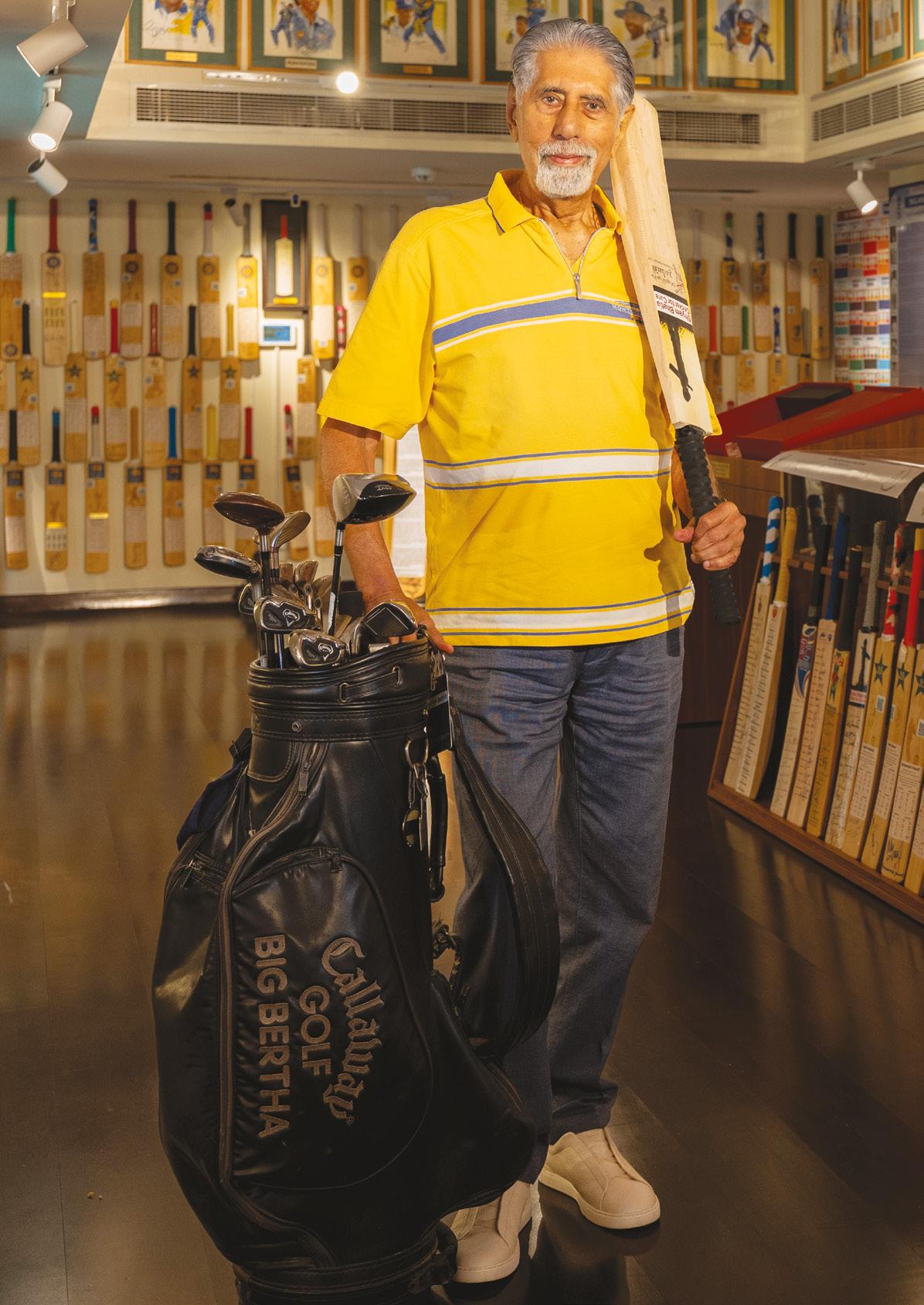



Photography: Alex Leyno
For Shyam Bhatia, sport isn’t just a pastimeit’s a way of life. An Indian-born entrepreneur who has called Dubai home for more than 40 years, Bhatia’s passion for sport runs deep and crosses boundaries.
His remarkable journey started on the cricket field, where as a young fast bowler, he fell in love with the game. But injuries forced him to hang up his cricket whites, prompting him to find a new way to stay connected to sport.
Bhatia soon turned his attention and energy toward golf and tennis – two disciplines that challenged him in different ways, yet kept alive his competitive spirit.
His love for golf blossomed after 1993 when the Dubai Creek Golf & Yacht Club came up near his office in the Deira side of Dubai. Shyam wasted no time to become a member as soon became a regular in social three balls and four balls at the picturesque venue.
His passion for the game struck a unique moment in 2011 when he was teamed with Charl Schwartzel at the Abu Dhabi HSBC Championship Pro-Am – just months before the South African star secured a dramatic Masters title at Augusta National.
Although shoulder issues have forced him off the course, golf, alongside cricket and tennis, remains an integral part of his life.
physically taxing but just as challenging mentally. Sir Gary Sobers was one of the greatest cricketers that ever lived. He was a terrific golfer too – a scratch golfer who played right-handed!
AShyam’s role has evolved from fierce competitor to passionate guardian of cricket’s rich legacy. In 2008, driven by a deep reverence for the game’s history, he opened the Shyam Bhatia Cricket Museum in the serenity of his back garden – a remarkable sanctuary filled with a vast collection of autographed cricket bats, balls, gear, photographs, and literature.
More than just a private collection, the museum is a profoundly intimate space where stories come alive, and the rich heritage of cricket finds a permanent home.
His remarkable story underscores a lifelong love of sport as he revealed in an exclusive interview with Worldwide Golf.
WWG: You’re widely known for your love of cricket, but golf was also a major part of your life. When did that begin?
Shyam Bhatia: I used to be a fast bowler when I played cricket, but after two back surgeries, I had to give it up. Luckily for me golf came into my life at just the right time. My office was on the Deira side of town, close to the Dubai Creek Golf & Yacht Club, and I decided to become a member in 1993. That’s when golf really captured my attention – it challenged me in a whole new way and kept me connected to the sport. In 2001 I moved my membership to Emirates Golf Club.
Coming from cricket, did your background help your golf game in any way?
Certainly! Both are striking a ball with a piece of equipment, and that made the transition a little smoother. But I fell into a few bad habits from cricket, like lifting my head too quickly. That affected my golf at first. Once I addressed those habits and kept my head down through the shot, I started to enjoy golf much more and appreciate its subtleties.
Why do you think so many retired cricketers gravitate toward golf?
Both cricket and golf require strong hand-eye coordination and a keen sense of timing. So it’s a natural progression for many cricketers. It lets us stay competitive and enjoy a sport that’s less
Although you’ve stopped playing due to a shoulder issue, you still attend major tournaments?
I love attending all the big golf events in the UAE – the Hero Dubai Desert Classic, the DP World Tour Championship at Jumeirah Golf Estates, and the Abu Dhabi HSBC Championship at Yas Links. I don’t think I’ve missed a single edition of these tournaments. And when I can’t be there in person, I watch all the Majors on television. I love golf – it’s a huge part of my life.
What keeps you connected to the game?
I’m a sports lover at heart. Cricket was my first love, but golf and tennis soon followed. I played both when I was younger and now I enjoy following their progress. I’ve also been a regular at the Dubai Duty Free Tennis Championships since it started in 1993. Sport brings people together, and for me, it’s a lifelong passion.
How have you seen golf evolve in Dubai over the years?
It’s grown by leaps and bounds. The number of golf courses has multiplied, and the golf community has blossomed. Al Wasl and many companies have played a huge role in developing golf here. Now the game is spreading to the Northern Emirates – Sharjah, Ajman, Fujairah, Ras Al Khaimah – making it more accessible to everyone in the UAE. It’s wonderful to see.
Your cricket museum is iconic, have you ever thought of including a section on cricketersturned-golfers or golf memorabilia?
It’s an interesting thought, but the crossover golfers are not professional players. Still, I have great admiration for cricketers who have taken up golf – Kapil Dev, Brian Lara, and Kevin Pietersen. The great Kapil Dev, who led India to a World Cup win in 1983, is a wonderful golfer. His ability to connect with a golf ball is pure talent; you can’t teach that. I think he could have turned pro if he took up the game.
NOW THE GAME IS SPREADING TO THE NORTHERN EMIRATES - SHARJAH, AJMAN, FUJAIRAH, RAS AL KHAIMAH - MAKING IT MORE ACCESSIBLE TO EVERYONE IN THE UAE. IT’S WONDERFUL TO SEE.
You’ve supported underprivileged cricketers for years. Do you see golf becoming more accessible in the same way?
I haven’t really addressed that side of golf. Cricket is a team sport – you give a team a kit, and everyone can enjoy it. I do this for children in the UAE, India, and elsewhere. Golf, on the other hand, is more restrictive – it’s not something you can equip a whole school in the same way. But hopefully, over time, initiatives will emerge to make golf more open.

How can golf become more accessible in the UAE?
I think the UAE could do more to make golf accessible to everyone by developing more public golf courses, places where people who can’t afford expensive memberships at private clubs can simply pay and play when they wish. The cost of joining a golf club here is quite high, and that can put the sport out of reach for a lot of people who might be interested in trying it.
It would be wonderful if there were more facilities designed to be welcoming and affordable, whether you’re a beginner who wants to learn, a family looking for a fun weekend activity, or a young person who’d like to pursue golf more seriously. Making golf more accessible in this way would help grow the game in the UAE, bring in a new generation of players, and show that golf isn’t just for the elite -it’s a sport everyone can enjoy.
What advice would you give young sports enthusiasts who are passionate about more than one sport?
I’d say when you’re young, make the most of it, try all the games you can, from cricket and football to athletics or swimming. See where your skills lie, what you naturally enjoy, and what sparks that feeling of pure happiness when you play. It’s a wonderful time to explore without pressure, to learn different techniques, challenge yourself in new disciplines, and discover what you’re really passionate about.
Once you find a sport you love and want to pursue more seriously, you can start focusing on it. But keep in mind that trying different sports when you’re growing up makes you a more complete athlete – it develops all-round skills, adaptability, and a deep understanding of competition. It also means you’re less likely to burn out or become injured from overtraining in a single discipline. Variety not only makes you a better sportsperson, but a more adaptable, resilient person in all walks of life.
So embrace it. Experiment. Have fun. Your path will become clear soon enough – and all those experiences will make you a stronger athlete and person in the long run.
How has your perspective on sports and competition changed over the years – from being a player to now a mentor, collector, and fan?
I’ve enjoyed every stage of my life in sport, from the rush of competition as a young player, to the privilege of mentoring the next generation and now preserving its rich past. Each phase has brought me a different kind of satisfaction. As a player, it was all about the pure competition, testing myself against the best, experiencing the highs and lows first-hand, and making friendships that last a lifetime.
As a mentor, it became more about guiding and helping others realize their potential – not just in sport, but in life. There’s a unique happiness that comes from seeing a young person grow, learn from their struggles, and find their own way forward.
Now, as a collector and a passionate fan, I appreciate a whole different side of the game. I’m not just reliving the past; I’m preserving it, collecting stories, souvenirs, and moments that connect us across generations. It’s a passion that lets me celebrate the rich history of sport and pass it on to future generations. I’m proud to be a guardian of that legacy, making sure it’s kept alive for years to come, and that the love of the game, in all its forms, is shared by those who follow in our footsteps.


“
BOTH ARE STRIKING A BALL WITH A PIECE OF EQUIPMENT, AND THAT MADE THE TRANSITION A LITTLE SMOOTHER. BUT I FELL INTO A FEW BAD HABITS FROM CRICKET, LIKE LIFTING MY HEAD TOO QUICKLY. THAT AFFECTED MY GOLF AT FIRST. ONCE I ADDRESSED THOSE HABITS AND KEPT MY HEAD DOWN THROUGH THE SHOT, I STARTED TO ENJOY GOLF MUCH MORE AND APPRECIATE ITS SUBTLETIES.”


t just 22 years old, Sam Mullane is already turning heads in the UAE golfing scene. A fixture on the UAE National Team, Sam’s golfing story started, like many young prodigies, with simple group lessons alongside his brother at Emirates Golf Club. “I started when I was about five or six,” he recalls. “We used to go down to Emirates Golf Club for group sessions. It was a fun way to start, and I got hooked early on.”
AWhat’s kept him swinging ever since? “The competitiveness,” he says with a grin. “That winning feeling is unmatched. There’s something about golf that just keeps pulling you back—the challenge, the grind, the occasional perfect shot.”
Growing up in Dubai, Sam has enjoyed year-round sunshine— ideal conditions, you’d think, but as he points out, Dubai summers are “practically unplayable.” With temperatures soaring beyond 45°C, you’d be mad to tee it up midday in July. “There are definitely advantages,” he says. “You can play all year round, which helps with development, but the summer is brutal. It gets to a point where you physically can’t play. That’s when I try to get away, play tournaments abroad, and see how I can adapt.”
Spain recently tested that adaptability. “It was totally different. The grass was different, the conditions were softer, and it really challenged how I approached every shot. It’s not easy when you’re used to firm and fast desert-style golf.”
Ask Sam about his golfing home away from home, and he instantly mentions Jumeirah Golf Estates. “Being a member here for several years, I love switching between the Fire and Earth courses,” he says. “Fire lets you score, then Earth humbles you—especially from the back tees. It’s a course that demands everything from you. Plus, the facilities here are the best in the
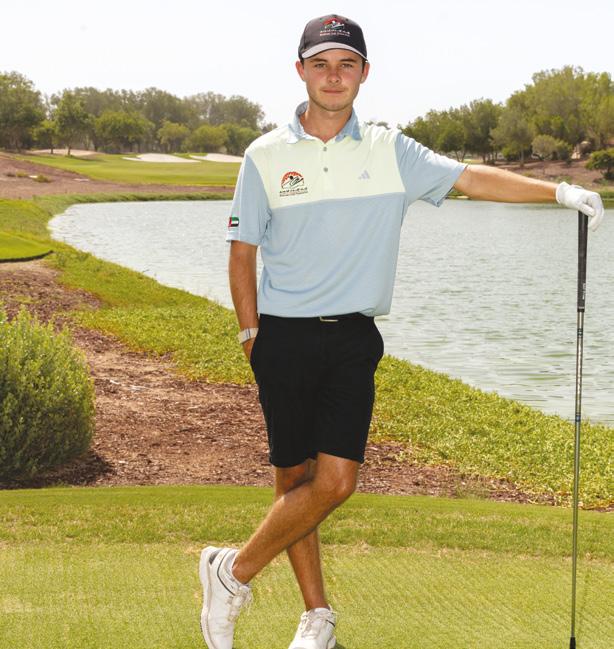
UAE. You can work on any part of your game, anytime.”
Sam is lucky to be in a place where professional inspiration is often just around the corner— literally. “Tommy Fleetwood is a huge local inspiration. He’s got his academy here, and sometimes you just see him on the range doing his thing. That’s pretty cool,” Sam says. “Globally, I’d say Collin Morikawa is a big one for me. I like his game because he’s not the longest hitter, and I’m not either. It’s more about precision, ball striking, strategy— that’s what I try to focus on.”
When it comes to practice, Sam breaks the mould. “A typical week really depends on whether I’m in the UAE or travelling and if I’ve got a tournament coming up. But in general, I don’t love the range,” he admits. “I get more out of being on the course—trying to score, shaping shots, working through different scenarios. That’s how I keep it fun and competitive.”
His game is already showing the polish of someone who takes their craft seriously. “My driving is one of my biggest strengths. I’m accurate off the tee and I hit a lot of fairways. My chipping is solid too—I’ve spent hours on the short-game area at TFA (Tommy Fleetwood Academy). It’s a great place to sharpen those skills.”
But even promising players have

their pain points. “My longer irons need work—especially from 170 to 210 yards,” he admits. “That’s my weakest area. Whether it’s a long par 3 or a second shot on a par 4, those clubs need to be dialled in. I’ve been grinding on them lately because I know at the next level, you can’t leave shots out there.”
This past season, Sam picked up three wins—no small feat. But one tournament, in particular, stands out. “The Cedars Championship really meant something. It was part of the Arab Golf Series, a new initiative from the Arab Golf


Federation. The field was strong, with players from around the GCC. Winning there gave me a lot of confidence because it was a step up in terms of competition.”
When competing against seasoned professionals, the learning curve is steep. “It’s different from playing with mates,” he says. “These guys are trying to make a living. It’s intense. I played a HotelPlanner Tour event recently, and it was eyeopening. You go from being a top player at home to one of the many trying to prove themselves.”
The mental side, he says, is as challenging as the technical. “You have to believe you belong out there. You’ve got to play your own game and block everything else out. I haven’t quite cracked it yet, but I know it’s possible.”
That’s not to say he underestimates the leap required. “I don’t think amateurs realise how tough pro golf is. The level is so much higher, and unless you’ve played in one of those events, you don’t truly
“YOU HAVE TO BELIEVE YOU BELONG OUT THERE. YOU’VE GOT TO PLAY YOUR OWN GAME AND BLOCK EVERYTHING ELSE OUT. I HAVEN’T QUITE CRACKED IT YET, BUT I KNOW IT’S POSSIBLE.”
understand. Everything changes—the pace, the pressure, the course setup. It takes time to adjust.”
Sam’s long-term goal is as realistic as it is ambitious. “Everyone dreams of turning pro, but you’ve got to earn it,” he says. “You need to show that you can compete at the professional level while you’re still an amateur. That’s the test. My goal is to start performing well on the Asian Development Tour or HotelPlanner Tour. Then I’ll know I’m heading in the right direction.”
Off the course, Sam’s interests are as varied as his shot selection. “I’m a big F1 fan. Love watching the races, love the strategy. Football too—hard to avoid when you live in this part of the world. But something people might not expect is that I’m a big gamer.
“I spend a lot of time on my PC, listening to music, playing games—it’s how I unwind.”
He’s also caught the travel bug. “Travelling to different countries has opened my eyes,” he says. “Trying new food, hearing different languages, seeing how other people live—it gives you perspective. I’ve even got into photography while travelling. Just capturing those moments—it’s become a bit of a side passion.”
As Sam Mullane continues his journey from the UAE’s sun-soaked fairways to fairways around the world, one thing is clear—he’s not just another young talent. He’s got the mindset, the maturity, and the motivation to go far.
Whether that’s on the Asian Tour, the DP World Tour, or beyond, the next few years will be fascinating to watch.
And if you see a laser-straight drive splitting the fairway on the Earth course, chances are it’s Sam—working quietly, methodically, and always looking ahead to the next challenge.

Photography: Alex Leyno

Ever wonder why sometimes you see a pro on TV hitting a shot from a cart path? Don’t they get free relief? Today, we’re going to explain why.
According to Rule 16.1, which covers free relief from abnormal course conditions, if there’s interference and you’ve got a reasonable shot, you usually get free relief.
So, what exactly counts as interference?
Interference exists when your ball is on, in, or touching the abnormal course conditions, or if it affects your stance or swing. And only when your ball is on the putting green, interference also includes your line of play.
If it’s just close enough to distract you but doesn’t meet any of those, there’s no free relief.
There’s no free relief if the shot doesn’t make sense, like if your ball’s deep in a bush where you have no shot at all, or if you pick an odd stance just to get free relief.
Unless you pick an odd stance because that’s the “only” reasonable way to play that shot, for example, you are a right-handed player and your ball is near a boundary wall on the left side of the hole. There’s no room to swing right-handed, so you decide to play a left-handed shot. But while setting up for that swing, you have to stand on a cart path. Since the left-handed shot is a reasonable in this situation, you are allowed free relief. And after taking relief, you can switch back to a right-handed swing. If your stance or swing is again affected by the cart path, you can
take relief again.
But If you pick a driver to play 50 yards in a deep rough just so you can stand on a cart path, there’s no free relief for you.
Keep in mind that, the nearest point of relief doesn’t mean a favorable spot. There’s no guarantee you’ll get a good lie after the drop. It could be better or worse.
If you take relief from the cart path, you’re getting away from the cart path, not from a bad lie.
If your ball is in the rough but the nearest point of complete relief is in the fairway, you’re allowed to drop there. That’s your good luck. But sometimes, relief might put you on rocks or behind a tree.
That’s why you often see a professional choose to play from the cart path instead of getting free relief.
It’s important to check where you will drop before you pick up your ball, because sometimes playing it as it lies might be better. Once you pick it up, there’s no going back, if you lift the ball to take relief but then decide not to, it’ll cost you a 1-stroke penalty for moving your ball in play.
Also, when you decide to take free relief, make sure you get “full” relief. If you play with any interference left after the drop, you’ll get a general penalty (2 strokes in stroke play or loss of hole in match play). So, when you take relief from a cart path, make sure no part of your stance/swing is still touching it.
First, find the nearest point where there’s no interference, that’s your reference point. Then drop the ball within one club-length from there.
If your ball is in the general area, your relief area must also be in the general area, not closer to the hole, and gives you full relief from what you’re getting relief for. You may clean or change the ball before dropping.
Free relief for ball in Bunker, the steps are almost the same as in the general area but your relief area must be in the bunker. If there’s no spot that gives you complete relief, you can still drop at the point of maximum available relief.
Or, as an extra option with a 1-stroke penalty, you may take backon-the-line relief outside the bunker.
Free relief for ball on Putting Green, just find a nearest spot where there’s no interference and “place” a ball on that spot (not drop, even that spot turns out to be off the green).
You can get relief anywhere on the course, except when your ball is in a penalty area.
There’s no free relief from a normal immovable obstruction on your line of play.
Many people confuse normal immovable obstructions with TIOs. Often, you see professional on TV getting free relief from something like a leaderboard on their line of play, it’s because the tournament uses a local rule for Temporary Immovable Obstructions (TIOs), which gives extra relief options for certain obstructions.
Also, be sure to check the local rules as sometimes, the committee may use a local rule that limits free relief if only your stance is affected by certain things like animal holes.




Think you know your DP World Tour glory stories from your Pro V1 trivia? Time to put that big golfing brain to the test. We’re giving away 6 dozen Titleist Pro V1 balls—yes, that’s enough ammo to last you through every shank, splashdown and miraculous up-and-down you’ll manage this season.From Tyrrell Hatton tearing up the Desert Classic to Ludvig Åberg’s Scandinavian charge, this year’s Tour has served up more drama than a clubhouse lunch queue. And let’s face it, who doesn’t want to strut around the first tee with a fresh sleeve of the #1 ball in golf?
All you need to do is answer these 10 questions—some tricky, some easier than a tap-in—and you could be rolling in Pro V1s.
Who won the 2025 Commerical Bank Qatar Masters?
a) Rory McIlroy
b) Tyrrell Hatton
c) Haotong Li
Who topped the 2024 DP World Tour Rankings presented by Rolex after the season finale in Dubai?
a) Viktor Hovland
b) Rory McIlroy
c) Shane Lowry
Which Titleist ball model celebrated its 25th anniversary this year?
a) Tour Soft
b) AVX
c) Pro V1
At which Dubai course did Tyrrell Hatton fire a final-round 69 to win the 2025 Hero Dubai Desert Classic?
a) Jumeirah Golf Estates – Earth Course
b) Emirates Golf Club – Majlis Course
c) Abu Dhabi Golf Club
True or False: The Titleist Pro V1 and Pro V1x are both triple-layer golf balls.
a) True
b) False
Which Titleist staff player from the USA clinched the 2024 BMW PGA Championship at Wentworth?
a) Billy Horschel
b) Collin Morikawa
c) Max Homa
What is the official slogan used by Titleist in their global marketing campaigns?
a) Play Like a Pro
b) The #1 Ball in Golf
c) Find Your Edge
Which rising Scandinavian talent won the Genesis Invitational on the PGA TOUR using Titleist gear?
a) Nicolai Højgaard
b) Ludvig Åberg
c) Victor Perez
Which European Tour legend won the 2025 U.S. Senior Open?
a) Berhnard Langer
b) Darren Clarke
c) Padraig Harrinton
What does “Pro V1” actually stand for?
a) Professional Victory 1
b) Pro Velocity 1
c) Proven 1
Email your answers to comps@worldwide.golf

Subject line: Titleist Prov1 Comp 2025
Include your full name and contact number.
Deadline: Midnight, August 31, 2025.
Winner picked at random, using data protected app Vondy, from all correct entries. One lucky golfer will be stuffing their locker with 6 dozen Titleist Pro V1s.







